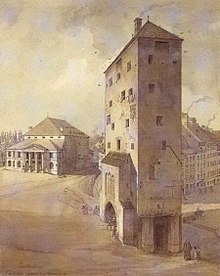Isartortheater

The Isartortheater , actually the Royal Court Theater on the Isarthor , was a classical theater building in Munich . It was built in 1811–1812 and destroyed in World War II.
location
The Isartortheater was located in the Isarvorstadt west of the Isartor , roughly at the eastern tip of today's green area between Frauenstrasse and Westenriederstrasse.
history
The theater building was built in 1811–1812 as the second theater of the royal court by Emanuel Herigoyen (1746–1817). An originally planned northern side wing was not implemented.
The theater on 10 October 1812 the presence of King opened I. Maximilian and Crown Prince Ludwig , the occasion of the upcoming name festival of his father from 1805 to 1814 to the Electorate of Bavaria belonging Innsbruck had traveled.
By 1822 at the latest, it became clear to the public that the theater might close: Director Carl Carl (1787–1854), who had taken over the management from founder Carl August de la Motte (1768–1841), was extremely successful with a program of popular entertainment , whereby Carl's self-confident work was not seen without envy and criticism. When the state funding was cut for the Isartortheater in favor of the first stage in the country, the court and national theater , and criticism of Carl's repertoire and performance grew stronger, Carl concluded with Ferdinand Graf Pálffy von Erdőd (1774-1840) on July 22, 1825 ), the owner of the Theater an der Wien , signed a guest performance contract for the months of August and September, which was subsequently also taken note of by the royal Bavarian court. As a result, the theater was closed from August 1825 or was no longer used in its dedication: Director Carl moved with the ensemble of 26 members to Vienna , where he wanted to perform at the Theater an der Wien from August 18, 1825, among other things, those pieces that were in Munich were not well received. Carl, who had promised to return to the Isartor with his ensemble in November 1825, took over the stage on the Wien River the next year , which he directed, including various closing times, until April 30, 1845 and made him a millionaire.
From 1844 to 1931 the building served as a municipal pawnshop . Towards the end of the 19th century, the southern side wing on Frauenstrasse was demolished. In 1931 the building was converted into a cinema and was in operation until 1944 under the name "Atlantik-Palast".
During the air raids on Munich in World War II , the building burned down completely. The ruin stood until 1953 and was then removed.
description
A two-storey, cubic entrance building with a hipped roof was preceded by a portico with four Tuscan columns that carried a triangular gable. The main building was three-story with a knee-length floor and also had a hipped roof. The auditorium offered space for 1200 people.
Actors and performances
In its first years the theater also saw opera performances, among others Peter Joseph von Lindpaintner worked here.
literature
- Heinrich Habel, Johannes Hallinger, Timm Weski: State capital Munich - center (= Bavarian State Office for Monument Preservation [Hrsg.]: Monuments in Bavaria . Volume I.2 / 1 ). Karl M. Lipp Verlag, Munich 2009, ISBN 978-3-87490-586-2 , p. 1203 .
Individual evidence
- ↑ Rheinischer Bund. (...) The one in Munich, in front of the Isarthore (...). In: Oesterreichisch-Kaiserliche privilegirte Wiener-Zeitung , No. 89/1812, October 22, 1812, p. 372, top left. (Online at ANNO ). .
- ↑ Should the Isarthor Theater be retained or should it be closed? . In: Flora . An entertainment sheet . July 30, 1822, No. 120/1822. Lentner, Munich 1822, p. 478 ff.
- ↑ Miscell. (...) The legend is renewed (...) . In: Flora. An entertainment sheet . August 24, 1822, No. 135/1822. Lentner, Munich 1822, p. 539, bottom right, f.
- ↑ Karl Carl. 1825 to 1845 . In: Anton Bauer: 150 years of Theater an der Wien . Amalthea-Verlag, Zurich, Vienna a. a. 1952, p. 116.
- ↑ (Karl) Carl: General theatrical scoreboard. (...) Theatrical news. In: Allgemeine Theaterzeitung and entertainment newspaper for friends of art, literature and social life , No. 99/1825 (18th year), August 18, 1825, p. 408, center right. (Online at ANNO ). .
- ↑ News. (...) From Munich, August 1st, 1825. (...) The royal (iche) Theater am Isarthor in its more limited sphere (...). In: Allgemeine Theaterzeitung and entertainment newspaper for friends of art, literature and social life , No. 98/1825 (18th year), August 16, 1825, p. 404, center right. (Online at ANNO ). .
Coordinates: 48 ° 8 ′ 5.6 " N , 11 ° 34 ′ 52.2" E